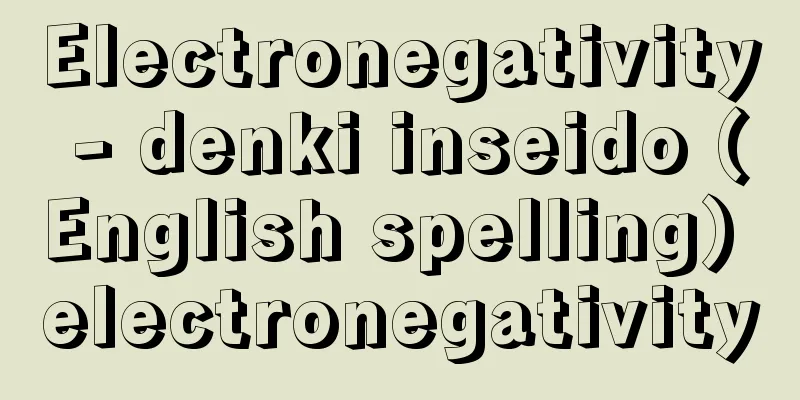Electronegativity - denki inseido (English spelling) electronegativity

|
This refers to the ability of one atom in a molecule to attract electrons to itself. For example, if there is a molecule A-B consisting of two different atoms, the greater the difference in electronegativity between atoms A and B, the more the electrons involved in the bond will be attracted to one of the atoms, and the greater the ionic character of the bond. On the other hand, the smaller the difference in electronegativity is and the closer it is to zero, the greater the degree to which electrons are shared by the two atoms, and the stronger the covalent bond. There are various opinions on how to determine the scale of electronegativity, and several practical approaches have been put forward, but the following three methods are the most well-known. (1) This was proposed by L.C. Pauling of the United States in 1932, and is calculated based on bond energy. In other words, when the contribution of ionicity in A-B is ΔAB , bonds such as A- A and B-B are bonds between the same elements, so the ionicity is considered to be small, and the bond energies DAB , DAA , and DBB are (2) Proposed by the American R.S. Mulliken in 1934, it has a value related to the sum of the ionization potential I (the energy required to remove one electron) and the electron affinity E (the energy released when adding one electron) of each atom. In other words, he theoretically proved that the electronegativity is proportional to the average value of I and E between two atoms in a molecule. This idea is quite reasonable, and its value is almost the same as Pauling's electronegativity when divided by 3.15. (3) In contrast to these, the measurement method proposed by Albert Louis Allred (1931-) and Eugene George Rochow (1909-2002) in 1958 is very widely used as it matches reality. In other words, an electron in a bond is subjected to a force such as Z * e 2 / r 2 ( Z * is the effective nuclear charge acting on the electron) according to Coulomb's law, and by relating this to the measured value, the electronegativity χ is given as follows: As can be seen from the above, the value of electronegativity of an element changes when the atoms bonded to it are different, and also when the molecular structure changes and the bonding state changes, but generally it takes the value of the most common state. The value that is most commonly used today is the Allred-Rochow value. [Nakahara Katsunori] [References] | | law| | | |©Shogakukan "> Electronegativity of elements Source: Shogakukan Encyclopedia Nipponica About Encyclopedia Nipponica Information | Legend |
|
分子内で一つの原子がその原子自身に電子を引き付ける能力をいう。たとえば、2種の異なる原子からなる分子A―Bがあるとき、これらのAとBの原子の電気陰性度の差が大きいほど、結合にあずかる電子は一方の原子に引き付けられることとなり、結合のイオン性が大きくなる。これに対し、電気陰性度の差が小さくなり零に近くなるほど、電子は2原子に共有される度合いが大きく、共有結合性が強くなる。 電気陰性度の尺度を決めるには、種々の意見があり、実際にあうような考え方がいくつか提出されているが、次の三つの方法がもっともよく知られている。 (1)1932年、アメリカのL・C・ポーリングによって提唱されたもので、結合エネルギーを基にして計算されている。すなわちA―Bにおけるイオン性の寄与をΔABとしたとき、A―AやB―Bのような結合は同種元素間の結合であるから、イオン性は小さいとみなし、それぞれの結合エネルギーDAB,DAA,DBBの間には (2)1934年、アメリカのR・S・マリケンによって提唱されたもので、各原子のイオン化ポテンシャルI(電子を一つ取り去るときに必要なエネルギー)と電子親和力E(電子を一つ付加するときに放出されるエネルギー)との和に関連した値をとっている。すなわち彼は、電気陰性度が分子内での二つの原子間のIとEとの平均値に比例することを理論的に証明した。この考え方はきわめて妥当なもので、その値もポーリングの電気陰性度と比べて3.15で割ったときほぼ対応した値となる。 (3)これらに対し、1958年にオールレッドAlbert Louis Allred(1931― )とロコウEugene George Rochow(1909―2002)が新しく提唱した実測による方法は、実際にあうものとしてきわめてよく用いられる。すなわち、一つの結合にある電子は、クーロンの法則によってZ*e2/r2(Z*はその電子に及ぼす有効核電荷)のような力を受けるが、これを実測の値と対応させて、電気陰性度χは、 以上のような考え方からもわかるように、電気陰性度の値は、一つの元素についていえば結合する相手の原子が違えば変わってくるし、また分子構造が変わり結合状態が違ってくると変わるが、一般的にはもっとも普通の状態の値をとることが多い。現在多く用いられるのがオールレッド‐ロコウの値である。 [中原勝儼] [参照項目] | | | | | |©Shogakukan"> 元素の電気陰性度 出典 小学館 日本大百科全書(ニッポニカ)日本大百科全書(ニッポニカ)について 情報 | 凡例 |
<<: Electric fish - denkiuo (English spelling) electric fish
>>: Electricity - denki (English spelling)
Recommend
Enryaku Ritual Book
It is also called "Ise Taijingu Rites," ...
Moira (English spelling)
Greek goddesses of fate. Usually the plural Moira...
Rooftop garden
A literary magazine. It was first published in Oc...
landscape design
…Until then, it was called saku seizai (landscape...
Administrative affairs - gyoseijimu
This was the concept before the decentralization ...
In Judgement - Zaihan
[Noun] (Suru) 1. A copy of an ancient document, et...
Windbreak - Windbreak
This is the simplest style of dwelling found among...
Luxembourg [city] (English spelling)
The capital of the Grand Duchy of Luxembourg. It i...
The Third Man
British film. 1949 production. Set in Vienna just...
High frequency heating - high frequency heating
A heating method that uses electromagnetic fields...
Aotodomatsu - Aotodomatsu
→ Todomatsu Source : Heibonsha Encyclopedia About ...
satinpod
…It is also called Ginsensou (silver fan grass) o...
Ephetai - Ephetai
...The ordinary popular tribunal (hēliaia) consis...
Marwari Capital - Marwari Literature
The Banias (merchant caste) of Rajasthan in northw...
《Zeitschrift für Sozialforschung》 (English notation) Zeitschriftfur Sozialforschung
...A general term for a group of thinkers who wer...









